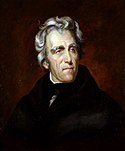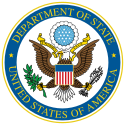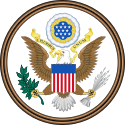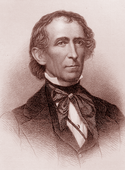John C. Calhoun
 John Calhoun (1849) | |
| Pełne imię i nazwisko | John Caldwell Calhoun |
|---|---|
| Data i miejsce urodzenia | 18 marca 1782 |
| Data i miejsce śmierci | 30 marca 1850 |
| 7. wiceprezydent Stanów Zjednoczonych | |
| Okres | od 4 marca 1825 |
| Przynależność polityczna | |
| Druga dama | Floride Calhoun |
| Poprzednik | |
| Następca | |
| Sekretarz stanu USA | |
| Okres | od 1 kwietnia 1844 |
| Poprzednik | |
| Następca | |
| Sekretarz wojny USA | |
| Okres | od 6 października 1817 |
| Poprzednik | |
| Następca | |
John Caldwell Calhoun (ur. 18 marca 1782 w Abbeville w Karolinie Południowej, zm. 30 marca 1850 w Waszyngtonie) – amerykański polityk, działacz Partii Demokratyczno-Republikańskiej, 7. wiceprezydent Stanów Zjednoczonych.
W latach 1817–1825 był sekretarzem wojny w administracji prezydenta Jamesa Monroe, następnie wiceprezydentem przy prezydentach Johnie Quincy Adamsie i Andrew Jacksonie (od 1825); 28 grudnia 1832 był pierwszym wiceprezydentem USA w historii, który sam zrezygnował z pełnionej funkcji, gdy został senatorem z rodzinnego stanu Karolina Południowa.
W 1844 został sekretarzem stanu w administracji Johna Tylera (po tragicznej śmierci Abla P. Upshura); pełnił tę funkcję przez rok, do końca prezydentury Tylera. W 1957 Senat USA uznał Calhouna za jednego z pięciu najwybitniejszych senatorów w historii USA.
Najgorętszy zwolennik utrzymania niewolnictwa. Wobec napływających do Kongresu petycji o zniesienie niewolnictwa w Waszyngtonie i terytoriach kontrolowanych przez władze federalne doprowadził do uchwalenia ustaw kagańcowych (ang. gag laws) zabraniających dyskutowania sprawy niewolnictwa. Zakaz ten (naruszający wolność słowa i petycji gwarantowany przez 1 Poprawkę) uchylony został w 1844 dzięki agitacji byłego prezydenta Johna Quincy Adamsa[1]. Calhoun sprzeciwił się też projektowi Wilmota, zakazującemu wprowadzenia niewolnictwa na tereny zdobyte w wojnie z Meksykiem[2]. Oponował też przeciw kompromisowi 1850, który ograniczał ekspansję niewolnictwa, jego mowę w tej sprawie trzeba było odczytać, gdyż on sam był już poważnie chory i wkrótce potem zmarł[3].
Przypisy
Linki zewnętrzne
- Biografia w Biographical Directory of the United States Congress (ang.)
- Biografia Senat Stanów Zjednoczonych (ang.)
- Biografia Office of the Historian, Bureau of Public Affairs, Departament Stanu Stanów Zjednoczonych (ang.)
- ISNI: 0000 0001 0884 6869
- VIAF: 32010914
- LCCN: n79137102
- GND: 11867532X
- NDL: 00435103
- LIBRIS: 75kmmfqr14w4hk0
- BnF: 12028615g
- SUDOC: 028453999
- SBN: CFIV038088
- NLA: 35024688
- NKC: kup19940000013218
- BNE: XX902592
- NTA: 07036639X
- CiNii: DA00588616
- Open Library: OL32486A, OL4487611A
- PLWABN: 9810671707205606, 9810546328105606
- NUKAT: n2005001286
- J9U: 987007277132605171
- PTBNP: 859698
- CANTIC: a10777933
- NSK: 000285948
- ΕΒΕ: 244341
- WorldCat: lccn-n79137102
Media użyte na tej stronie
Logo of the Democratic Party of the United States. Dark blue D inside a dark blue circle.
Andrew Jackson - 7th President of the United States (1829–1837)
Whole-plate daguerreotype of John C. Calhoun, which sold at auction for $338,500 USD on 06 April 2011. The daguerreotype was copied by Charles G. Crehen and published as a lithograph in 1850.
Logo of the United States White House, especially in conjunction with offices like the Chief of Staff and Press Secretary.
Seal of the Vice President of the United States. The blazon is defined in Executive Order 11884 as:
The design is the same as the Seal of the President of the United States, except that there is no ring of stars, the clouds are gray (instead of proper), the stars are gray (instead of argent), the scroll is gray (instead of white), the arrows are gray (instead of proper), and the background colors and inscription (obviously) differ.The Coat of Arms of the Vice President of the United States shall be of the following design:
SHIELD: Paleways of thirteen pieces argent and gules, a chief azure; upon the breast of an American eagle displayed holding in his dexter talon an olive branch proper and in his sinister a bundle of thirteen arrows gray, and in his beak a gray scroll inscribed "E PLURIBUS UNUM" sable.
CREST: Behind and above the eagle a radiating glory or, on which appears an arc of thirteen cloud puffs gray, and a constellation of thirteen mullets gray.
The Seal of the Vice President of the United States shall consist of the Coat of Arms encircled by the words "Vice President of the United States."
Signature of South Carolina politician John C. Calhoun




















